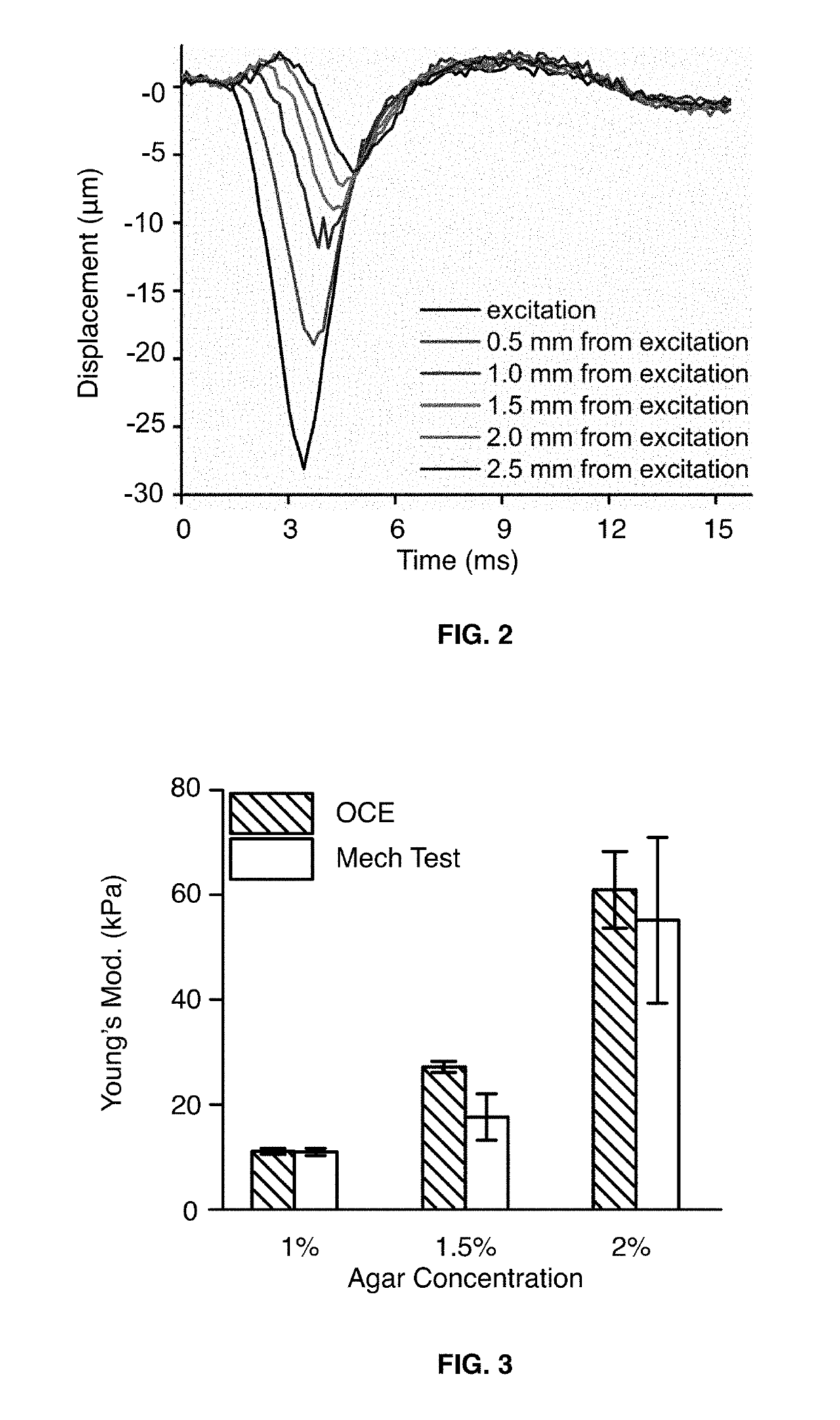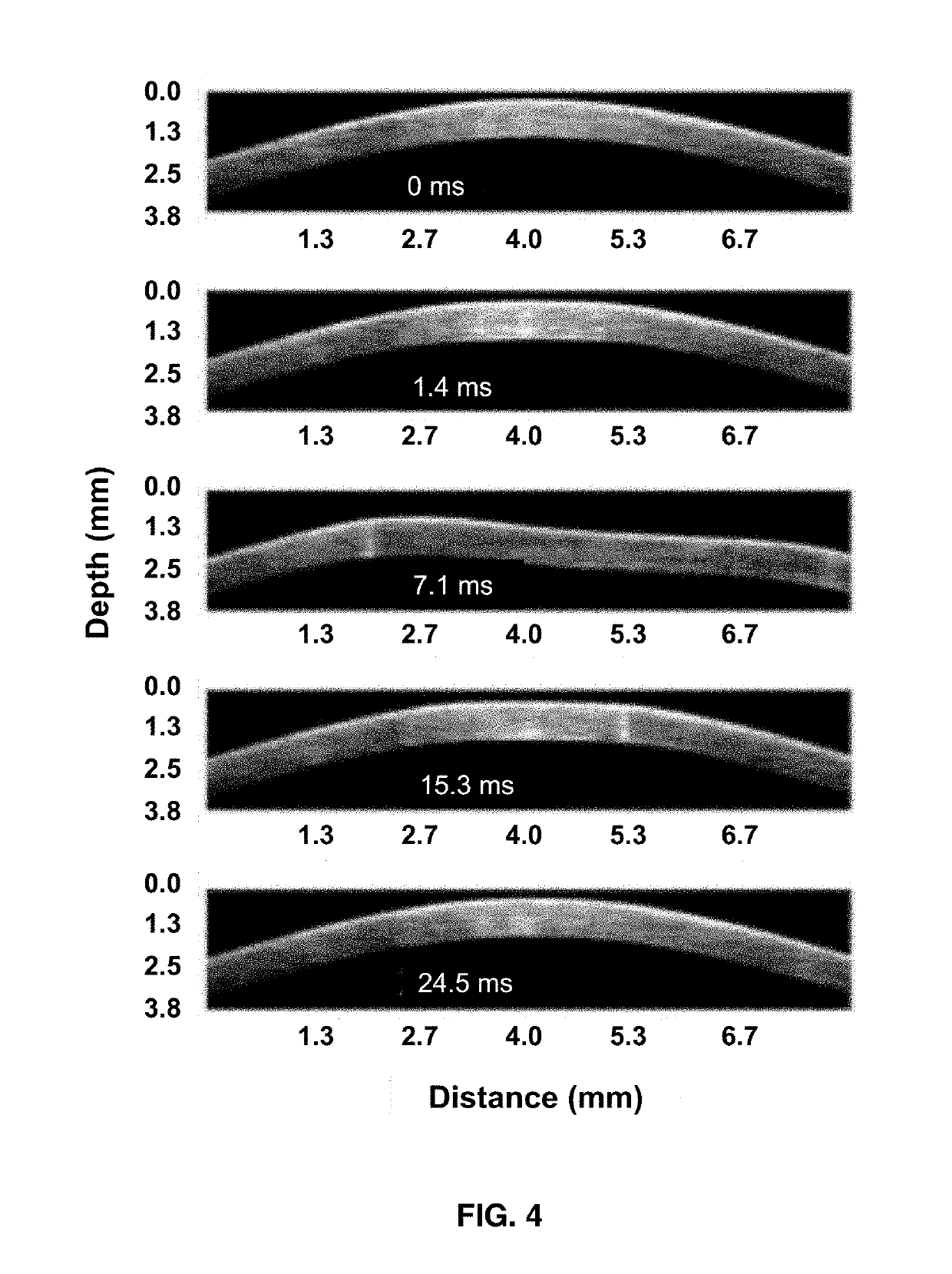System and Method for Measuring Intraocular Pressure and Ocular Tissue Biomechanical Properties
- Summary
- Abstract
- Description
- Claims
- Application Information
AI Technical Summary
Benefits of technology
Problems solved by technology
Method used
Image
Examples
example 1
Materials and Methods
Agar Phantom Samples
[0046]Tissue-mimicking agar phantoms (Difco nutrient agar, Beckton, Dickinson and Company, Sparks, Md., USA) were used. Concentrations (w / w) of agar are 1%, 1.5% and 2%, n=3 of each concentration.
Porcine Eyes
[0047]Fresh porcine eyes (Sioux-Preme Packing Company, Sioux City, Iowa; n=3) are used. Extraneous tissues such as muscles are removed from the eye-globes and all measurements were taken within 24 h of enucleation. The whole eye-globes were placed in a home-built holder for artificial IOP control (17). During testing, the eye-globes are cannulated with two 23 G needles for an artificial IOP control. One needle was connected via tubing to a pressure transducer and the other needle was connected via tubing to a microinfusion pump.
Video
[0048]Video of noncontact applanation (Video 1) or elastic wave propagation (Video 2) was imaged at a frame rate of ˜7.3 kHz.
[0049]Video 1, MP4, 6.5 MB, dx.doi.org / 10.1117 / 1.JBO.22.2.020502.1; and
[0050]Video 2...
example 2
Phase-Sensitive Swept-Source Optical Coherence Tomography (PhS-SSOCT) Imaging Subsystem
[0051]The phase-sensitive swept source Optical Coherence Tomography system (PhS-SSOCT) (see FIG. 1) imaging system utilizes a 4× buffered Fourier domain model locked (FDML) swept source laser with an A-scan or sweep rate of ˜1.5 MHz, a central wavelength of ˜1316 nm, a scan range of ˜100 nm, an axial resolution of ˜16 μm, a phase stability of ˜14 nm, and a resonant scanner at ˜7.3 kHz. The PhS-SSOCT optical imaging system is utilized to image the dynamic spatio-temporal deformation of the cornea in response to the air-puff and detect the nano to micrometer-scale displacements induced by the focused air-pulse. The PhS-SSOCT imaging system is controlled by a computer comprising at least a processor, memory, analog-to-digital (ADC) and digital-to-analog (DAC) converters, a display, and other requisite software and hardware to operate the system and at least one network connectio...
example 3
PhS-SSOCT Assessment of Elasticity of Optical Samples
Agar Phantom
[0053]The propagation of the air-pulse induced elastic wave in a tissue-mimicking agar phantom is illustrated in FIG. 2. The temporal vertical displacement profiles at the indicated distances are plotted. The distances are at about 0.5 mm, 1.0 mm, 1.5 mm, 2.0 mm and 2.5 mm away from the air-pulse excitation. The largest displacement at all the distance appears at the time of about 3 ms, and the displacement is fully recovered after about 6 ms for all the excitation distances. The wave propagation, attenuation, and dispersion can be observed from the shape of the profiles at the various distances and can be also be used to calculate biomechanical properties.
[0054]In order to validate the optical coherence elastography technique, the stiffness of agar phantoms of various concentrations (1%, 1.5%, and 2% w / w, n=3 of each concertation) assessed by optical coherence elastography and measured by the “gold standard” uniaxial ...
PUM
 Login to View More
Login to View More Abstract
Description
Claims
Application Information
 Login to View More
Login to View More - R&D
- Intellectual Property
- Life Sciences
- Materials
- Tech Scout
- Unparalleled Data Quality
- Higher Quality Content
- 60% Fewer Hallucinations
Browse by: Latest US Patents, China's latest patents, Technical Efficacy Thesaurus, Application Domain, Technology Topic, Popular Technical Reports.
© 2025 PatSnap. All rights reserved.Legal|Privacy policy|Modern Slavery Act Transparency Statement|Sitemap|About US| Contact US: help@patsnap.com



